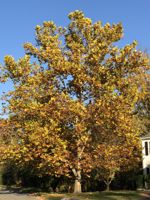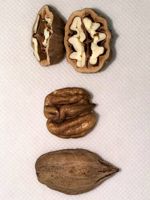Mon-Fri 9am - 5pm Mountain time
American Sycamore vs Burton Hican
Platanus occidentalis
Carya ovata x illinoinensis Burton
NOT AVAILABLE THIS SEASON - MIGHT RETURN
NOT AVAILABLE THIS SEASON - MIGHT RETURN
American Sycamore is the largest tree native to eastern North America. Generally too large and messy to be a street tree, American Sycamore thrives in large, open spaces, such as an acreage or farm.
The bark is one of the main features that draw people to this tree. The outer bark flakes off in irregular pieces to reveal an attractive white, green, and cream colored inner layer, providing winter interest.
American Sycamore has an extremely fast growth rate, gaining up to 6 ft in one year, and will easily reach its mature height in a short period of time. Be wary of this trees' root system, as it's typically very extensive and needs lots of room to expand.
Burton Hican is a rare cross between Shagbark Hickory and Pecan. Most Hickory x Pecan hybrids are not reliable producers but the Burton Hican produces large crops annually (in warmer climates). The medium sized nuts fall in between the Pecan and Hickory and are known for having a great flavor. They are well suited to fresh eating, cooking, and baking with a good storage life.
Hicans will carry features from both species. The Hickory influence causes earlier ripening times while the taste and productivity come from the Pecan. The Pecan genetics also cause the nuts to have a thinner shell that is easier to crack and the pecan-like shape makes kernel removal easier.
The Burton Hican is generally considered self pollinating but having a second variety for cross pollination will increase nut production. They have been known to cross pollinate with other Hicans, Shagbark Hickory, and some Pecans. Nut production is expected after 7-10 years.
Note: Plant this tree once. Due to its large tap root transplanting is not recommended.

